Join More Than 50,000+ Subscribers and get latest camera news and rumors
NEW CAMERA VIDEOS ON YOUTUBE
|
By admin, on December 12th, 2011
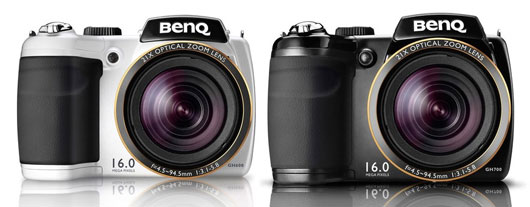 Both the BenQ camera uses Sony Sensors, BenQ GH600 uses 16 Megapixel CCD sensor whereas BenQ GH700 comes with 16 Megapixel BSI CMOS Sensor, Due to BIS CMOS Sensor you get better low light performance, HDR mode and Full HD movie mode. CMOS sensors uses less power compared to CCD sensors hence you get better battery life in GH700, Read the comparison review below for detail specification comparison. Both the BenQ camera uses Sony Sensors, BenQ GH600 uses 16 Megapixel CCD sensor whereas BenQ GH700 comes with 16 Megapixel BSI CMOS Sensor, Due to BIS CMOS Sensor you get better low light performance, HDR mode and Full HD movie mode. CMOS sensors uses less power compared to CCD sensors hence you get better battery life in GH700, Read the comparison review below for detail specification comparison.
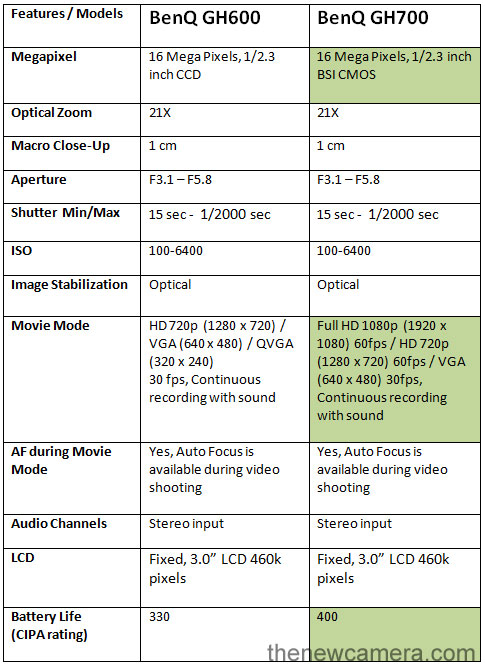 BenQ GH 600 vs BenQ GH700 comparison review BenQ GH 600 vs BenQ GH700 comparison review
The BenQ GH600 comes with CCD sensor whereas the BenQ GH700 comes with The back – illuminated BSI CMOS sensor increases sensitivity by two times and minimizes the noise level by up to 50%, delivering stunning results in low – light situations.
The GH700 features a high-speed, high – efficiency digital signal processor (DSP) that enhances the processing speed by up to 30%.
The BenQ GH600 captures 720p HD @ 30fps with sound whereas BenQ GH 700 1080p Full HD videos at 60fps with Stereo Sound.
GH700 has a built-in wind cut function so audio recorded can have minimum unwanted background noise. On GH700, there is also an interdependent recording button that provides a quick access to start recording instantaneously so nothing will be missed; while pressing the shutter button during recording will capture a still shot. Truly an exceptional camera whether the user is an aspiring photographer or videographer.
HDR III Image Enhancement Technology in GH700
HDR III utilizes the exposure bracketing technique to take three photos with different exposures and combine them to create a stunning image that’s more balanced in contrast and brightness. The BSI CMOS sensor and DSP can then effectively refine and enrich the foreground and background details to add a finishing touch to the HDR image.
Continuous Shooting Mode in GH700
- High – Speed Burst: Press down the shutter button to shoot up to ten 16M high – resolution photos.
- Pre – shooting: Press the shutter button half way down to shoot up to five images before the shutter button is fully pressed.
- Sporty Burst: Take 54 1M fast-action photos with a high shutter speed of either 1/120 or 1/240.
- Smart Selector: To take a continuous shot, press and hold down the shutter button .And release it to stop. Only the sharpest photo will be saved.
- Multi – Shot 16: Press and hold down the shutter button to take 16 consecutive photos at 30 frames per second. The shots will be automatically combined into one photo.
Conclusion: Overall Winner BenQ GH700, Both the BenQ camera shares same lens and display unit, BenQ GH700 comes with CMOS sensor and a faster image processing engine for better performance, you also get high speed Burst mode and creative tools such as in Camera HDR mode in GH700, GH700 available from January 2012 in online stores.
By admin, on November 29th, 2011
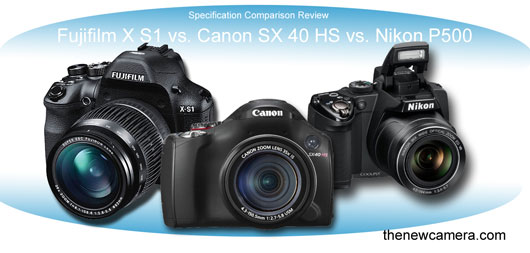
Fujifilm X S1 features bigger sensor but comes at high price with limited 26X optical Zoom Lens on the other hand Canon SX 40 HS comes half price and features 35X optical Zoom, which camera you will buy and why? Read the Specification Comparison review of Fujifilm X S1 with Canon SX40 HS and Nikon P500 and share your thoughts with us.
Buy Fujifilm X S1 from Amazon || Amazon UK
Buy Canon SX 40 HS from Amazon || Amazon UK || Adorama || B&H
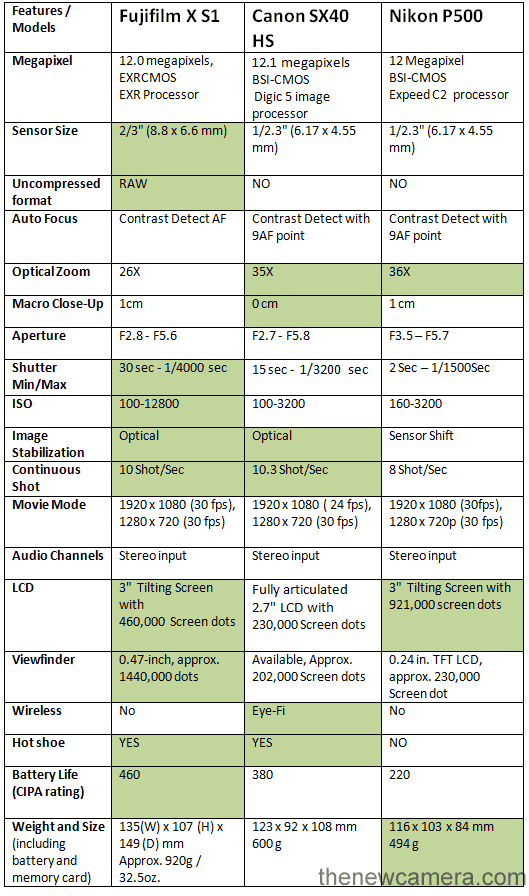
About Sensor and processor
Fujifilm X S1 features bigger sensor compared to Canon SX 40HS and Nikon P500, The sensor is not only bigger but Fuji X S1 uses same sensor of Fuji X 10 (Pro compact camera) and in several test done by Fujifilm and others we found that Fuji X 10 sensor is better compared to Canon G12.
The new sensor of fuji X S1 allows you Capture 3 exposures of the same scene with high-speed continuous shooting, each at a different dynamic range setting (100%, 200% and 400%).
But we should not forget about canon SX 40 HS Sensor and image processor, Canon SX 40 HS uses newly developed BSI CMOS sensor and DIGIC 5 image processor, the Digic 5 image processor creates 75% less noise and 6X faster compared to Digic 4 image processor, Due to new sensor and image processor you get more details and less noise in high ISO settings.
Multi-area White Balance in SX 40 HS: The Canon SX40 HS features advanced Multi-area White Balance optimizing color tones of both subject and background under multiple light sources.
Nikon P500 image sensor captures more noise and less details compared to Canon SX 40 HS (See here).
Image Processor: Image processor of both Canon and Fuji are very fast, both can capture 10 shot/sec in high speed shooting mode, Nikon P500 is limited to 8 shot/sec only.
RAW: Only Fujifilm X S1 features RAW format capture, Fujifilm X S1 features in camera RAW converter, The conversion of RAW data not only takes into account exposure compensation, white balance and other in-camera image quality control settings, but also lets the user apply Film Simulation modes in the converter mode. For PC you get
AF Points: Fuji not mentioned in its specification chart but during research we found that Fujifilm X S1 features 49 selectable AF points, Canon and Nikon Features 9 AF points.
IS Image Stabilization
| |
Fujifilm |
Canon SX 40 HS |
Nikon P500 |
| Image Stabilization |
Optical |
Optical |
Sensor Shift and VR |
| IS Modes(Hybrid IS) |
Not Available |
Available (Normal, Macro, Panning, Dynamic, Powered, Tripod) |
Not Available |
Fuji Claims Fujifilm X S1 Equipped with a newly developed image stabilization mechanism, X-S1 effectively compensates for camera shake even when you press the shutter to capture a subject at extreme zoom. No further details available about the IS system of X S1.
Canon SX 40HS features 6 IS Modes and Optical IS The new Hybrid System of Canon SX 40 HS features Six Intelligent IS Modes, Canon SX 40 HS automatically chooses from six different modes (Normal, Macro, Panning, Dynamic, Powered, Tripod) to optimize image stabilization and help achieve crisp, blur-free images for various shooting conditions
Nikon features Image sensor shift(not optical) + electronic vibration reduction (VR) function. Images captured with image sensor shift vibration reduction enabled are further processed with electronic VR for images that are sharper and exhibit less blur.
Lens and Aperture Range
| Camera / Specification |
Fujifilm X S1 |
Canon SX 40 HS |
Nikon P500 |
| Optical Zoom |
26X |
35X |
36X |
| Macro |
1cm |
0 cm |
1 cm |
| Aperture |
F2.8 – F5.6 |
F2.7 – F5.8 |
F3.5 – F5.7 |
Based on lens quality, aperture and optical zoom range canon SX 40 HS is a clear winner, Fujifilm Zoom lens is limited to 26X only.
Canon features UD glass, double-sided aspherical glass-molded and ultra-high-refraction-index glass lens elements to effectively suppress chromatic aberration while maintaining a remarkably compact size. The camera uses a VCM (Voice Coil Motor) for high-speed, quiet, energy-efficient lens movement with precise control.
Similarly as canon, Fuji features high optical performance glass lens elements (aspherical, high refractive index, and ED glass lenses) make the exceptional brightness of F2.8 at wide angle and F5.6 at telephoto possible.
Nikon P500 features 36x Zoom and NIKKOR ED glass.
Shutter Speed
You get more range in shutter speed in Fujifilm X S1 compared to SX 40 HS or Nikon P500.
| Shutter Speed |
Fujifilm X S1 |
Canon SX 40 HS |
Nikon P500 |
| Max |
4000 Sec |
3200 Sec |
1/1500 Sec |
| Min |
30 Sec |
15 Sec |
2 Sec |
| Continuous Shot |
10 Shot/Sec |
10.3 Shot/Sec |
8 Shot/Sec |
Movie Mode
All the three Megazoom camera offers Full HD Video recording and AF during Video mode. Fuji offers Full HD at 30 fps, Canon Full HS at 24 fps and Nikon Full HD at 30 fps.
Display: Practically I like Canon vari-angle display, but Nikon Wins here, Nikon P500 features 3″ Tilting Screen with 921,000 screen dots and Fully articulated 2.7″ LCD with 230,000 Screen dots.
Viewfinder: Fuji is a clear winner, it features a 0.47-inch superb high resolution viewfinder (approx. 1440,000 screen dots) with eye sensor.
Batter Life: Based on CIPA rating the Fujifilm X S1 battery life is better compared to Canon SX40 HS and Nikon P500.
Size and Weight: Nikon wins here, The Fuji weight and Size is similar to entry level DSLRs, Fuji weight (Max) 920g and have bigger body Compared to Canon and Nikon.
Price
| Camera Models |
Fujifilm X S1 |
Canon SX 40 HS |
Nikon P500 |
| Price (List Price) |
$800 |
$429 |
$399 |
The Price of Fujifilm is just double the price of current Megazoom camera, will you pay double price for a bit bigger sensor or you will buy Canon or nikon?
Overall Conclusion
Best Megazoom: If you want a MegaZoom Camera Canon SX40 HS is a clear winner, canon SX 40 HS 35X Zoom Lens features excellent optics with Hybrid IS, Fujifilm X S1 is limited to 26X only.
Buy Fujifilm X S1 from Amazon || Amazon UK
Buy Canon SX 40 HS from Amazon || Amazon UK || Adorama || B&H
Image quality and dynamic range: Fujifilm X S1 Wins here, The X S1 uses same sensor as pro compact camera X10, you get RAW file, more control over the dynamic range while shooting.
Fujifilm X S1 Available from Feb at Amazon and other stores
By admin, on November 9th, 2011

Panasonic GX1 specification comparison review: Panasonic GX1 vs. Sony NEX 5N vs Olympys E PL3, does Panasonic GX1 have enough features to beat Sony NEX 5N and Olympus E PL3? Read the Specification Comparison review and get your answer.
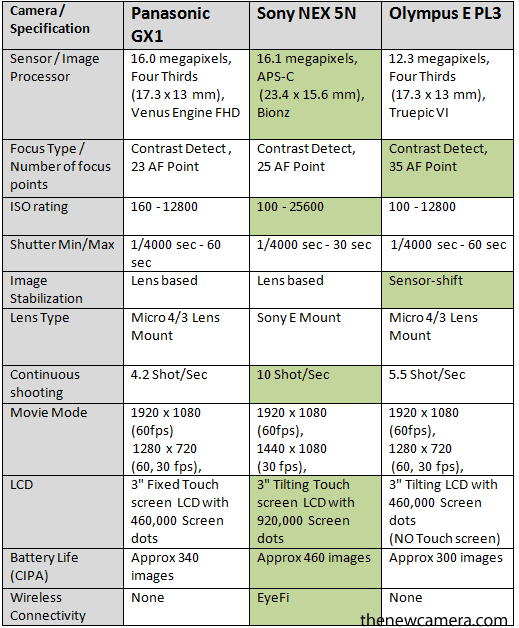
Sensor: The sensor of Sony NEX 5N is 16.1 MP Exmor APS HD CMOS image sensor, Sony NEX 5N Sensor is bigger and better, you get more Dynamic range and better low light performance compared to Panasonic GX1 and Olympus E PL3.
Image processor: the brain of Sony NEX 5N is fast compared to Panasonic GX1 and Olympus E PL3, The new image processor in Sony NEX 5N is a refined version of Sony’s BIONZ image processor.
The Sony New BIONZ image processor enables fast processing for up to 10 fps continuous shooting of data-intensive 16.1 megapixel images, 2D/3D Sweep Panorama modes and 6 image layering.
Auto Focus: The Olympus E PL3 offers 35 separate focus points that are spread over nearly the entire sensor, The Sony NEX 5N offers 25 AF point and Panasonic GX1 offers 23 AF Point.
The 35 AF points of Olympus helps you for pin-point accurate focusing on small subjects wherever they appear in the frame. Selectable 3×3 groups within the 35-point area are especially effective when shooting active subjects.
Manual Focus: The Sony NEX 5N offers peaking AF Display for Manual AF, It make manual focusing much easier by highlighting the edges that are in focus in your choice of three colors (white, red, or yellow).
ISO Rating: The Sony NEX 5N offers large APS-C Sensor and 25600 MAX ISO range, better than the Panasonic GX1 and Olympus E P3.
Sony’s BIONZ image processor chroma noise reduction delivers high-resolution, low-noise photos even at ISO 25600 sensitivity.
Shutter Range: The Olympus E PL3 and Panasonic GX1 offers a bit more Min shutter range compared to Sony NEX 5N.
Image Stabilization: Olympus E PL3 offers in camera sensor shift image stabilization, it helps while shooting with prime lenses in low light condition.
Continuous shooting: Sony NEX 5N offers 10 Shot/Sec speed, better compared Olympus E PL3 and Panasonic GX1.
Movie Mode: All the three Mirrorless camera offers Full HD Video recording at 60fps.
Display / LCD: The Sony NEX 5N offers high resolution 3” 921K dots Tilting Touch Screen LCD, The TruBlack screen includes a special resin layer to suppress internal reflections, increasing contrast compared to conventional LCDs. Sunny Weather mode boosts visibility even further in bright sunlight.
Batter Life: According to CIPA standard you capture 430 shots on a single charge with Sony lithium ion Stamina battery power, Sony NEX 5N offers longest battery life compared to Panasonic GX1 and Olympus E PL3.
Conclusion: Sony NEX 5N is a clear winner, if you are looking forward to Mirrorless camera, go ahead and buy the Sony NEX 5N. It’s worth the money.
Buy Sony NEX 5N from Amazon || See more buying options
Buy Panasonic GX1 || Buy Olympus E PL3
By admin, on October 30th, 2011
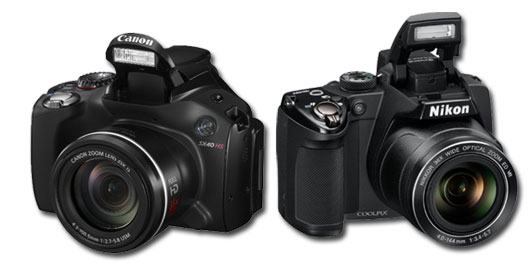 Canon SX 40 HS vs Nikon P500, See our super zoom camera comparison review below. Canon SX 40 HS vs Nikon P500, See our super zoom camera comparison review below.
Buy Canon SX 40 HS from Amazon | Amazon UK | Adorama
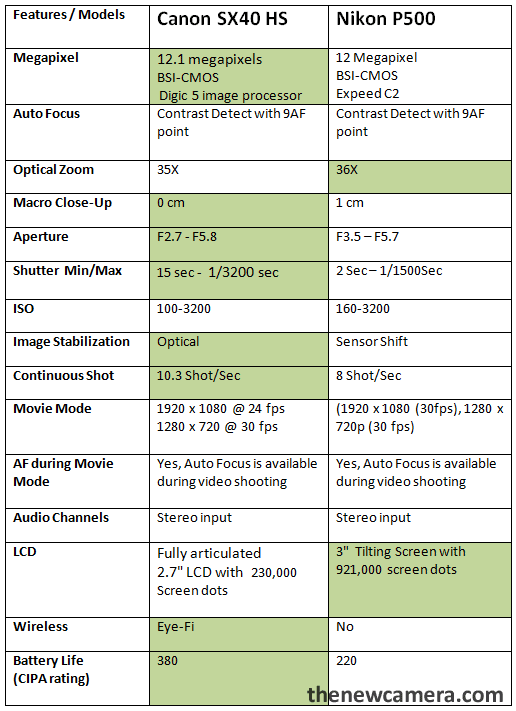
About Sensor and processor: Canon SX 40 HS uses newly developed BSI CMOS sensor and DIGIC 5 image processor, the Digic 5 image processor creates 75% less noise and 6X faster compared to Digic 4 image processor, Due to new sensor and image processor you get more details and less noise in high ISO settings.
The new image processor also features advanced Multi-area White Balance optimizing color tones of both subject and background under multiple light sources.
Image Quality: We have seen many high ISO sample from both the camera, , even at ISO 800 and 1600 Canon SX 40 HS images have less noise, better color and sharpness compared to Nikon P500.
IS Image Stabilization
| |
Canon SX 40 HS |
Nikon P500 |
| Image Stabilization |
Optical |
Sensor Shift and VR |
| IS Modes |
Available (Normal, Macro, Panning, Dynamic, Powered, Tripod) |
Not Available |
Canon SX 40 HS features better image stabilization compared to Nikon P500.
Canon SX 40HS features 6 IS Modes and Optical IS One of the most important innovations for a point-and-shoot camera has been Image Stabilization (IS) since it helps improve image quality by reducing camera blur for both images and videos. Canon has taken this technology one step further with the new Intelligent IS which automatically chooses from six different modes (Normal, Macro, Panning, Dynamic, Powered, Tripod) to optimize image stabilization and help achieve crisp, blur-free images for various shooting conditions
Nikon features Image sensor shift(not optical) + electronic vibration reduction (VR) function, images captured with image sensor shift vibration reduction enabled are further processed with electronic VR for images that are sharper and exhibit less blur.
Lens and Aperture Range
| Camera / Specification |
Canon SX 40 HS |
Nikon P500 |
| Optical Zoom |
35X |
36X |
| Macro |
0 cm |
1 cm |
| Aperture |
F2.7 – F5.8 |
F3.5 – F5.7 |
You get better lens, Aperture range and Macro mode in Canon SX 40 HS, Nikon P500 features 1X more Zoom Compared Canon SX 40 HS.
The Canon SX 40 HS features 35X optical zoom and the advanced design employs UD glass, double-sided aspherical glass-molded and ultra-high-refraction-index glass lens elements to effectively suppress chromatic aberration while maintaining a remarkably compact size. The camera uses a VCM (Voice Coil Motor) for high-speed, quiet, energy-efficient lens movement with precise control.
Nikon P500 features 36x Zoom and NIKKOR ED glass.
Shutter Speed: You get more range in shutter speed and faster burst rate in SX 40 HS, the Canon SX 40HS is better compared to Nikon P500
| Shutter Speed |
Canon SX 40 HS |
Nikon P500 |
| Max |
3200 Sec |
1/1500 Sec |
| Min |
15 Sec |
2 Sec |
| Continuous Shot |
10.3 Shot/Sec |
8 Shot/Sec |
High Speed Shooting: An added benefit of the DIGIC 5 image processor is the incorporation of the new High-speed Burst HQ providing users with the ability to continuously capture a maximum of 10 frames.
Movie Mode: Both features Full HD recording and AF during movie mode, at Canon you get 24 fps at Full HD and at Nikon your get 30 fps at Full HD, Nikon is a bit better.
Display: Nikon Wins here, Nikon P500 features 3″ Tilting Screen with 921,000 screen dots and Fully articulated 2.7″ LCD with 230,000 Screen dots.
Batter Life and other: Based on CIPA rating the Canon SX 40 HS battery life is better compared to Nikon P500. The Canon SX 40 HS supports Eye-Fi and weights 100gm(approx) more than Nikon P500.
Overall Conclusion: The Overall performance of SX 40HS is better compared to Nikon P500. Canon SX 40 HS is a clear winner.
Buy Canon SX 40 HS from Amazon | Amazon UK | Adorama
By admin, on October 29th, 2011
Many users and visitors of new camera asking about the Canon SX 40 HS image quality, they want to know which camera is more better and why? You can also jump to Specification review (Canon SX 40HS vs Nikon P500) but before that I want to answer one question…
The most asked question: Both Nikon P500 and Canon SX 40 HS features 12 megapixel BSI CMOS sensor, which one is more better and why?
Answer: The Canon SX 40 HS is more better compared to Nikon P500 in High ISO test.
See the image below. The Left side image(s) taken from Canon SX 40 HS have less noise, more sharper and have better color
Buy Canon SX 40 HS from Amazon
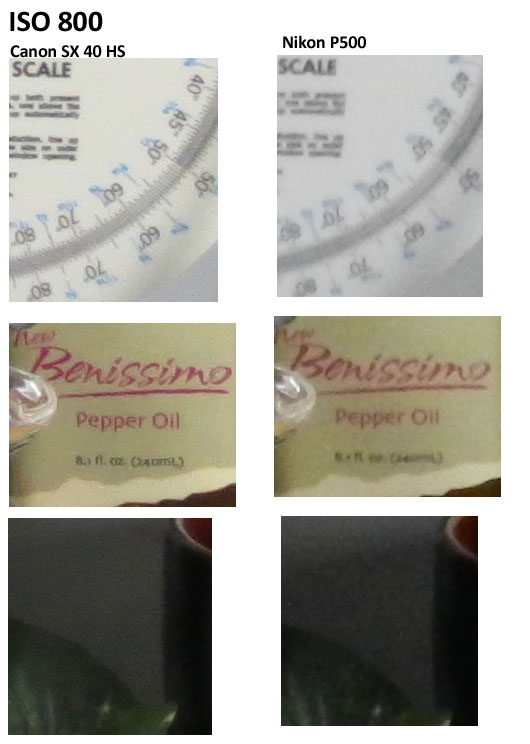 Image Copyright - Imagine Resource
Image Credit: imaging-resource.com
Canon SX 40 HS HIGH ISO Sample at Digital camera Info
Nikon P500 HIGH ISO Samples at Cnet
By admin, on October 15th, 2011
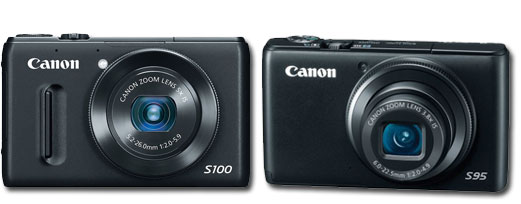
Canon S100 vs. Canon S95 Specification comparison review, Which one is more better and why? See the Specification comparison table and review(below).
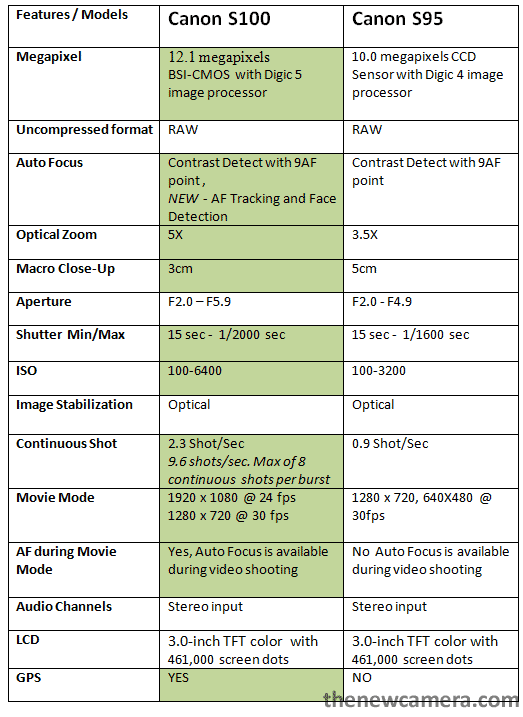
Canon S100 vs Canon S95:
Sensor: Canon S100 have new 12 megapixel CMOS Sensor with higher sensitivity, you get more megapixel and low noise.
Lens: The PowerShot S100 features 5X optical zoom and F2.0 – F5.9 Aperture, high performance lens developed and manufactured using the same methods and expertise as Canon’s leading EF lenses,
Image processor: New Digic V image processor of S100 is 6X faster and produces 75% less noise compared to Digic IV images processor of S95.
Improved low light performance: Due to Digic V image processor and new CMOS sensor, At ISO 1600 the Canon S100 creates 75% less noise compared to Canon S95.
New Intelligent IS – Canon’s highly-effective 4-stop optical Image Stabilizer to counter camera shake in stills and Full HD movies, Intelligent IS automatically identifies the scene and adapts the optical Image Stabilizer settings for optimal compensation.
Full HD with AF: Canon S100 features Full HD Video Recording at 24p, 5.0x optical zoom, AF can be used during video capture, while Dynamic IS and Powered IS mode within Intelligent IS counteract camera shake when recording whilst moving, or when using the zoom.
GPS: Canon PowerShot S100’s integrated GPS, supplied Map Utility software which integrates with Google Map.
LCD: Same LCD Screen as S95.
Conclusion: Upgrade from S95 to S100 is highly recommended.
Buy Canon S100 from Amazon , Amazon UK, B&H Store and Adorama.
See more – Canon SX40 HS vs Canon SX30 IS
By admin, on October 4th, 2011
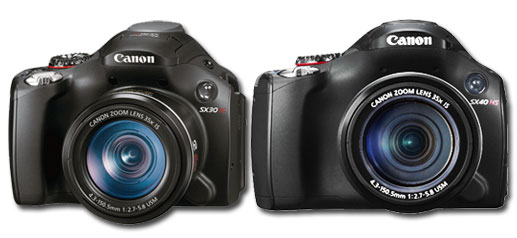
Buy Canon SX40 HS from Amazon || Buy Canon SX 40 HS from Amazon UK
Canon SX40 HS vs Canon SX30 IS, Which camera you should buy Canon SX40 HS or Canon SX30 IS, see the comparison review below and select your nest mega zoom camera.
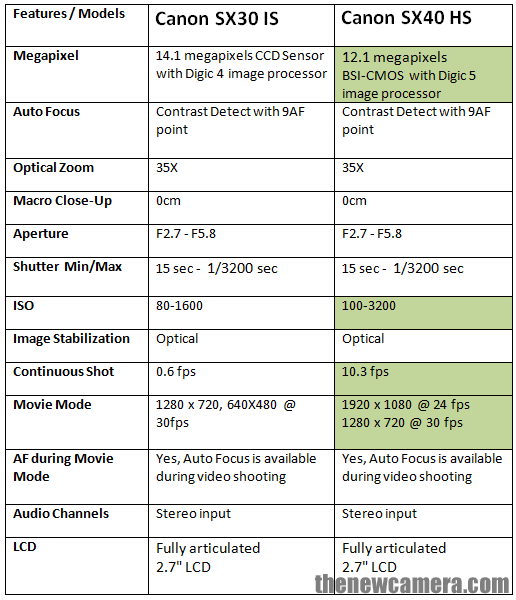
So What changed and What hasn’t changed form Canon SX30 IS to Canon SX40HS?
What hasn’t Changed?
The new canon SX40 HS Zoom Lens, The SX40 HS 35X zoom lens is same as canon SX30 IS, shutter speed and Display unit are same.
What Changed?
NEW Sensor: 12.1 Megapixel BSI CMOS Sensor, the new sensor features improved lowlight performance and true life colors.
The New Image processor Digic V: The New image processor features increase in processing speed and power. Improved chip architecture and algorithms, you get more clear and sharp images with true life color.
New fetures in Digic V processor
Hybrid white balance system: DIGIC 5 Image Processor also makes possible a new, highly advanced automatic white balance system. Whereas conventional white balance makes an overall adjustment based on a single type of light source, the new Canon Multi-Area White Balance analyzes several areas of the image to determine whether different adjustments are needed, for example, for the main subject and the background.
New Intelligent IS (Image Stabilization technology): Intelligent IS analyzes camera movement and applies the best shake correction method for the shooting situation. For stills, the system automatically selects among Normal, Panning, Macro (Hybrid) and Tripod IS modes. When shooting video, the system automatically selects among Dynamic, Powered, Macro and Tripod IS modes.
Improved ISO Range: The low light performance is improved in Canon SX40 HS, the new sensor features ISO range from 100 to 3200.
Continuous Shot: Canon SX40 HS features 10.3fps of continuous shooting.
Full HD Video Recording: Canon SX40 HS captures Full HD Video 1920 x 1080 @ 24 fps and HD Videos 1280 x 720 @ 30 fps, it also support Auto-Focus during movie mode.
Conclusion: Canon SX40 HS is better than the Canon SX 30 IS
Should you Upgrade from Canon SX 30 IS – I would say yes, you get better low light performance, better IS, 10.3fps of Continuous shooting mode and Full HD Video Recording.
Buy Canon SX40 HS from Amazon || Buy Canon SX 40 HS from Amazon UK
Support New Camera Buy Music CD or Digital Camera at amazon it helps this site, and you do not pay anything extra, it is just a way to help support this site.

|
KEEP THIS BLOG ALIVE - Support New Camera Buy Canon Lenses, Buy Music CD or Digital Camera at amazon it helps this site, and you do not pay anything extra, it is just a way to help support this site.

|
 Both the BenQ camera uses Sony Sensors, BenQ GH600 uses 16 Megapixel CCD sensor whereas BenQ GH700 comes with 16 Megapixel BSI CMOS Sensor, Due to BIS CMOS Sensor you get better low light performance, HDR mode and Full HD movie mode. CMOS sensors uses less power compared to CCD sensors hence you get better battery life in GH700, Read the comparison review below for detail specification comparison.
Both the BenQ camera uses Sony Sensors, BenQ GH600 uses 16 Megapixel CCD sensor whereas BenQ GH700 comes with 16 Megapixel BSI CMOS Sensor, Due to BIS CMOS Sensor you get better low light performance, HDR mode and Full HD movie mode. CMOS sensors uses less power compared to CCD sensors hence you get better battery life in GH700, Read the comparison review below for detail specification comparison. BenQ GH 600 vs BenQ GH700 comparison review
BenQ GH 600 vs BenQ GH700 comparison review




 Canon SX 40 HS vs Nikon P500, See our super zoom camera comparison review below.
Canon SX 40 HS vs Nikon P500, See our super zoom camera comparison review below.









